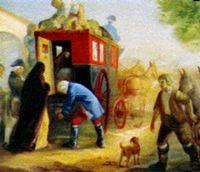Malapostas's history

The European carriage museums reflect the variety in European culture. The splendour of Royalty, the pride of nobility, but also the diligence of merchants and frugality of the bourgeois are recognizable. Craftsmen and artists made carriages like a mirror of European history.
As a result of the French Revolution and the abolishment of many monarchies only a few ancient Royal collections survived. The Portuguese and Austrian people saved their magnificent Royal and Imperial Court collections and erected the first public carriage museums in 1905 and 1918. Elsewhere carriages survived in castles, coach houses, farms and several museums, scattered all over the continent.
In 1958 the Dutch founded a National Carriage Museum, presenting an overview of the types which were in use from the 18th unto the 20th century. The Dutch museums gave their carriages to this new institute.
In the last decades many private carriage owners like to drive, to collect and to restore historical carriages. They find out how complicated it is to provide a safe haven for their collection. And they discover how valuable the original state of a vehicle can be, as a unique survivor of the past.
In this chapter you find the various museums that are linked to this portal. Together they publish a printed catalogue, composed of illustrated fiches of carriages. These fiches can be bought in the museumshops or by e-mail and they can be collected in special cassettes.
Etiquetas: Pessoal



















0 Comments:
Enviar um comentário
<< Home